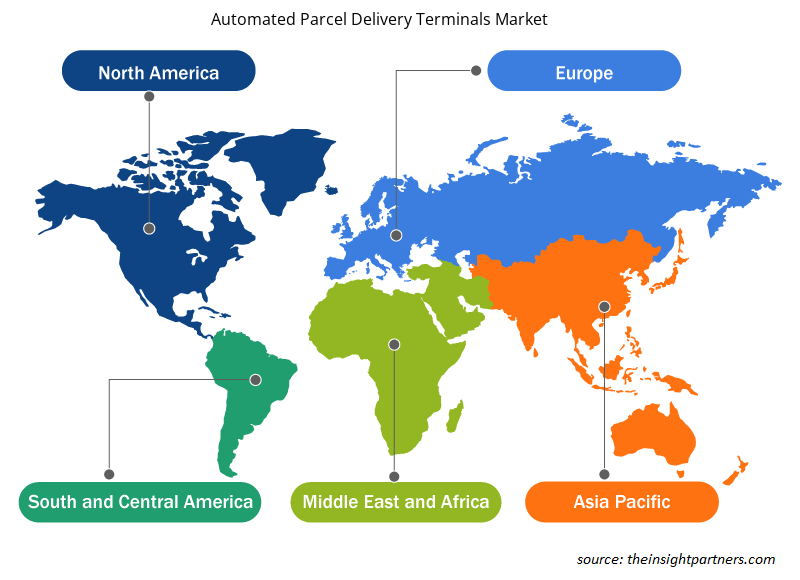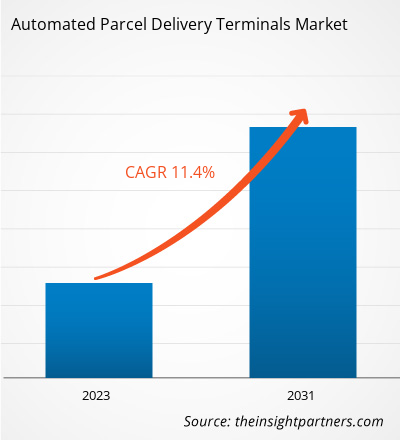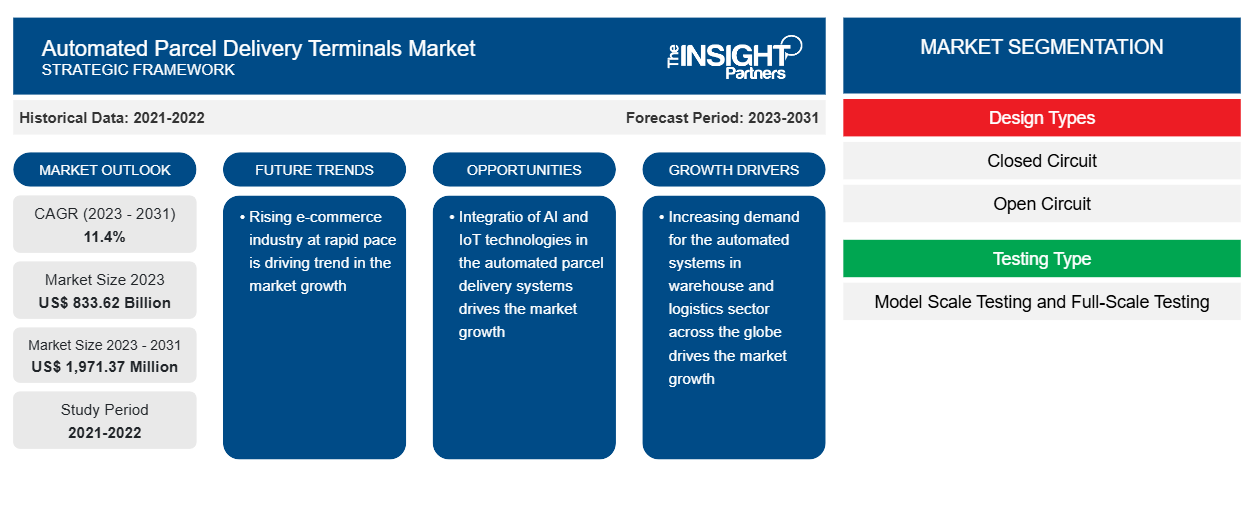Der Markt für automatisierte Paketzustellterminals soll von 833,62 Milliarden US-Dollar im Jahr 2023 auf 1.971,37 Millionen US-Dollar im Jahr 2031 anwachsen. Der Markt soll in den Jahren 2022–2031 eine durchschnittliche jährliche Wachstumsrate (CAGR) von 11,4 % verzeichnen. Automatisierte Paketzustellterminals sind automatisierte Schließfächer mit Selbstbedienungseinheiten, die die Paketzustellung rationalisieren sollen. Diese Terminals werden an stark frequentierten Orten wie Einkaufszentren, Einkaufspassagen, Einzelhandelsgeschäften, Supermärkten, Bushaltestellen, Flughäfen, Bahnhöfen und anderen öffentlichen Bereichen installiert. Der Hauptzweck dieser Paketzustellterminals besteht darin, Einzelpersonen eine sichere und bequeme Möglichkeit zu bieten, Pakete jederzeit abzugeben und abzuholen. Automatisierte Paketzustellterminals kombiniert mit fortschrittlichen Technologien, die darauf ausgelegt sind, die wachsende Nachfrage im Logistik- und Lagersektor zu decken.CAGR of 11.4% in 2022–2031. Automated parcel delivery terminals are the automated lockers with self-service units designed to streamline the parcel deliveries. These terminals are installed in high-traffic locations such as malls, shopping malls, retail stores, supermarkets, bus stands, airports, train stations, and other public areas. The main purpose of these parcel delivery terminals provide safe and convenient way for individuals to drop off and pick up packages at any time. Automated parcel delivery terminals combined with advanced technologies designed to meet growing logistics, and warehousing sector demand.
Marktanalyse für automatisierte Paketzustellungsterminals
Der Markt für automatisierte Paketzustellterminals wächst aufgrund der steigenden Nachfrage der Verbraucher nach kontaktlosen und bequemen Zustelloptionen rasant. Der technologische Fortschritt zur Verbesserung der Produktivität und der Lieferzeiten für die Verbraucher hat zu einer erheblichen Nachfrage nach dem Marktwachstum für automatisierte Paketzustellterminals geführt. Zu den fortschrittlichen Technologien gehören KI- und IoT- Integration zur Automatisierung der Paketzustelloptionen. Die wichtigsten Akteure auf dem Markt konzentrieren sich auf technologische Innovationen, um Probleme im Zusammenhang mit der Zustellung auf der letzten Meile zu lösen. Das weitere rasante Wachstum der E-Commerce-Branche mit zunehmenden Online-Shopping-Trends hat im Prognosezeitraum zu einer enormen Nachfrage nach dem Marktwachstum für automatisierte Paketzustellterminals geführt.
Marktübersicht für automatisierte Paketzustellungsterminals
Das zunehmende Wachstum der E-Commerce -Branche mit einem Anstieg des Online-Shoppings bei Verbrauchern auf der ganzen Welt hat im Prognosezeitraum eine enorme Nachfrage nach dem Marktwachstum für automatisierte Paketzustellterminals geschaffen. Laut der International Trade Administration Organization werden die weltweiten E-Commerce-Umsätze der B2B-Unternehmen bis 2026 voraussichtlich einen Wert von 36 Billionen US-Dollar erreichen. Dies wird von Schwerindustrien wie Fertigung, Gesundheitswesen, Energie und professionellen Geschäftsdienstleistungssegmenten angetrieben, die den größten Teil des Marktwachstums ausmachen. Die weltweit steigende Nachfrage nach automatisierten Systemen im Lager- und Logistiksektor treibt das Marktwachstum an.
Passen Sie diesen Bericht Ihren Anforderungen an
Sie erhalten kostenlos individuelle Anpassungen an jedem Bericht, einschließlich Teilen dieses Berichts oder einer Analyse auf Länderebene, eines Excel-Datenpakets sowie tolle Angebote und Rabatte für Start-ups und Universitäten.
-
Holen Sie sich die wichtigsten Markttrends aus diesem Bericht.Dieses KOSTENLOSE Beispiel umfasst eine Datenanalyse von Markttrends bis hin zu Schätzungen und Prognosen.
Markttreiber und Chancen für automatisierte Paketzustellungsterminals
Die steigende Nachfrage nach automatisierten Systemen im Lager- und Logistiksektor auf der ganzen Welt treibt das Marktwachstum an
Der Markt wird durch das schnelle Wachstum der E-Commerce-Branche angetrieben, das eine enorme Nachfrage nach dem Marktwachstum für automatisierte Paketzustellsysteme geschaffen hat. Dies hat die Nachfrage nach Marktwachstum für automatisierte Paketzustellterminals vorangetrieben.
Darüber hinaus verursachen Faktoren wie Lieferungen in abgelegene Gebiete und fehlgeschlagene Zustellversuche zusätzliche Kosten für die Unternehmen. Aus diesem Grund werden Selbstabhollösungen wie automatisierte Paketzustellterminals bei E-Commerce-Händlern immer beliebter.
Die weltweite Verbreitung von Mobiltelefonen und Internetzugang hat es Verbrauchern ermöglicht, Waren aus anderen Ländern zu kaufen. Man geht davon aus, dass die Zahl der Paketsendungen infolgedessen deutlich steigen wird. Einzelhändler heben auch die Verwendung alternativer Paketzustelloptionen hervor, um fehlgeschlagene und verspätete Lieferungen zu vermeiden.
Regierungen auf der ganzen Welt legen großen Wert auf die Digitalisierung und fördern bargeldlose Zahlungen, insbesondere in Entwicklungsländern wie China und Indien. Regierungen können ihre politischen Ziele einer digitalisierten, bargeldlosen und transparenteren Wirtschaft vorantreiben, indem sie die Nachnahmeoption (COD) in intelligenten Paketzustellterminals nutzen, die erfolgreiche und reibungslose Transaktionen zwischen Kunden und ihren Verbrauchern ermöglicht.
Die zunehmende Nutzung fortschrittlicher Technologien wie maschinelles Lernen, künstliche Intelligenz, Internet der Dinge und Blockchain treibt das Marktwachstum voran.
Die zunehmende Integration fortschrittlicher Technologien wie maschinelles Lernen, künstliche Intelligenz und das Internet der Dinge zur Einführung automatisierter Paketterminals eröffnet erhebliche Chancen auf dem Markt. Mehrere wichtige Akteure auf dem Markt entwickeln und bringen fortschrittliche Technologien auf der Grundlage automatisierter Paketzustellterminals auf den Markt. So brachte Oman Post, eine Tochtergesellschaft der Asyad Group, im November 2023 ein innovatives automatisiertes Paketterminal auf den Markt. Die hochmoderne Technologie trug zu einer 43-prozentigen Verbesserung der Betriebseffizienz bei, was wiederum die Kundenzufriedenheit verbessert. Das System wurde mit KI-Technologie implementiert, um die Produktivität zu verbessern und die Effizienz der Paketzustellung an die Kunden zu steigern. Dieses KI-basierte Terminal verarbeitet bis zu 6.000 Pakete pro Stunde und sortiert mehr als 12 Zeilen pro Lauf.
Segmentierungsanalyse des Marktberichts für automatisierte Paketzustellungsterminals
Wichtige Segmente, die zur Ableitung der Marktanalyse für automatisierte Paketzustellungsterminals beigetragen haben, sind Bereitstellung und Dienstanbieter.
- Basierend auf dem Einsatz wird der Markt in Innen- und Außenbereiche unterteilt.
- Basierend auf den Endbenutzern ist der Markt in Einzelhandel/E-Commerce, Versand/Logistik, Lager, Regierung und Sonstige unterteilt.
Marktanteilsanalyse für automatisierte Paketzustellungsterminals nach Geografie
Der geografische Umfang des Marktberichts zu automatisierten Paketzustellungsterminals ist hauptsächlich in fünf Regionen unterteilt: Nordamerika, Europa, Asien-Pazifik, Naher Osten und Afrika sowie Südamerika.
Nordamerika wird voraussichtlich das Marktwachstum dominieren, da dort die Einführung fortschrittlicher Technologien auf Basis automatisierter Paketzustellterminals schnell voranschreitet. Die USA und Kanada halten bedeutende Anteile am Weltmarkt, wobei die führenden Logistikunternehmen in den USA zunehmend in die Lagerautomatisierung investieren.
Aufgrund des weltweiten Wachstums der E-Commerce-Branche bieten sich in Entwicklungsländern im asiatisch-pazifischen Raum jedoch erhebliche Chancen, automatisierte Paketzustellterminals einzuführen. Indien und China sind die Länder mit der schnellsten Einführung automatisierter Paketzustellterminals. Mehrere führende Logistikdienstleister investieren erhebliche Beträge in die Anschaffung automatisierter Paketzustellterminals, um der wachsenden Nachfrage im Logistiksektor gerecht zu werden.
Regionale Einblicke in den Markt für automatisierte Paketzustellungsterminals
Die regionalen Trends und Faktoren, die den Markt für automatisierte Paketzustellterminals während des gesamten Prognosezeitraums beeinflussen, wurden von den Analysten von Insight Partners ausführlich erläutert. In diesem Abschnitt werden auch Marktsegmente und Geografie für automatisierte Paketzustellterminals in Nordamerika, Europa, im asiatisch-pazifischen Raum, im Nahen Osten und Afrika sowie in Süd- und Mittelamerika erörtert.

- Erhalten Sie regionale Daten zum Markt für automatisierte Paketzustellungsterminals
Umfang des Marktberichts über automatisierte Paketzustellungsterminals
| Berichtsattribut | Details |
|---|---|
| Marktgröße im Jahr 2023 | 833,62 Milliarden US-Dollar |
| Marktgröße bis 2031 | 1.971,37 Millionen US-Dollar |
| Globale CAGR (2023 - 2031) | 11,4 % |
| Historische Daten | 2021-2022 |
| Prognosezeitraum | 2023–2031 |
| Abgedeckte Segmente |
Nach Designtypen
|
| Abgedeckte Regionen und Länder |
Nordamerika
|
| Marktführer und wichtige Unternehmensprofile |
|
Marktteilnehmerdichte: Der Einfluss auf die Geschäftsdynamik
Der Markt für automatisierte Paketzustellterminals wächst rasant, angetrieben durch die steigende Nachfrage der Endnutzer aufgrund von Faktoren wie sich entwickelnden Verbraucherpräferenzen, technologischen Fortschritten und einem größeren Bewusstsein für die Vorteile des Produkts. Mit steigender Nachfrage erweitern Unternehmen ihr Angebot, entwickeln Innovationen, um die Bedürfnisse der Verbraucher zu erfüllen, und nutzen neue Trends, was das Marktwachstum weiter ankurbelt.
Die Marktteilnehmerdichte bezieht sich auf die Verteilung der Firmen oder Unternehmen, die in einem bestimmten Markt oder einer bestimmten Branche tätig sind. Sie gibt an, wie viele Wettbewerber (Marktteilnehmer) in einem bestimmten Marktraum im Verhältnis zu seiner Größe oder seinem gesamten Marktwert präsent sind.
Die wichtigsten auf dem Markt für automatisierte Paketzustellungsterminals tätigen Unternehmen sind:
- Smartbox E-Commerce-Lösungen Pvt. Ltd.
- Cleveron AS
- NeoPost-Gruppe
- Winnsen Industry Co., Ltd.
- TZ Limited
- VonBox Holdings Limited
Haftungsausschluss : Die oben aufgeführten Unternehmen sind nicht in einer bestimmten Reihenfolge aufgeführt.

- Erhalten Sie einen Überblick über die wichtigsten Akteure auf dem Markt für automatisierte Paketzustellungsterminals
Marktnachrichten und aktuelle Entwicklungen zu automatisierten Paketzustellungsterminals
Der Markt für automatisierte Paketzustellterminals wird durch die Erfassung qualitativer und quantitativer Daten nach Primär- und Sekundärforschung bewertet, die wichtige Unternehmensveröffentlichungen, Verbandsdaten und Datenbanken umfasst. Im Folgenden finden Sie eine Liste der Entwicklungen auf dem Markt für automatisierte Paketzustellterminals und Strategien:
- Im April 2021 brachte Cleveron, ein Unternehmen für Paketzustellungsroboter, das halbautonome Zustellfahrzeug Cleveron 701 auf den Markt. Es soll die Produktivität und Effizienz von Logistik- und Einzelhandelsunternehmen steigern, um die Zustellung von Paketen auf der letzten Meile zu verbessern. (Quelle: Flyability, Pressemitteilung/Unternehmenswebsite/Newsletter)
Marktbericht zu automatisierten Paketzustellungsterminals – Umfang und Ergebnisse
Der Bericht „Marktgröße und Prognose für automatisierte Paketzustellungsterminals (2021–2031)“ bietet eine detaillierte Analyse des Marktes, die die folgenden Bereiche abdeckt:
- Marktgröße und Prognose auf globaler, regionaler und Länderebene für alle wichtigen Marktsegmente, die im Rahmen des Projekts abgedeckt sind
- Marktdynamik wie Treiber, Beschränkungen und wichtige Chancen
- Wichtige Zukunftstrends
- Detaillierte Porter's Five Forces Analyse
- Globale und regionale Marktanalyse mit wichtigen Markttrends, wichtigen Akteuren, Vorschriften und aktuellen Marktentwicklungen
- Branchenlandschaft und Wettbewerbsanalyse, einschließlich Marktkonzentration, Heatmap-Analyse, prominenten Akteuren und aktuellen Entwicklungen
- Detaillierte Firmenprofile mit SWOT-Analyse
- Historische Analyse (2 Jahre), Basisjahr, Prognose (7 Jahre) mit CAGR
- PEST- und SWOT-Analyse
- Marktgröße Wert/Volumen – Global, Regional, Land
- Branchen- und Wettbewerbslandschaft
- Excel-Datensatz
Aktuelle Berichte
Erfahrungsberichte
Grund zum Kauf
- Fundierte Entscheidungsfindung
- Marktdynamik verstehen
- Wettbewerbsanalyse
- Kundeneinblicke
- Marktprognosen
- Risikominimierung
- Strategische Planung
- Investitionsbegründung
- Identifizierung neuer Märkte
- Verbesserung von Marketingstrategien
- Steigerung der Betriebseffizienz
- Anpassung an regulatorische Trends























 Kostenlose Probe anfordern für - Markt für automatisierte Paketzustellungsterminals
Kostenlose Probe anfordern für - Markt für automatisierte Paketzustellungsterminals